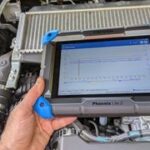California’s smog check program, overseen by the Department of Motor Vehicles (DMV), mandates that most vehicles undergo emissions testing. A critical part of this test involves the On-Board Diagnostics II (OBD2) system. This guide details the OBD2 requirements for passing a DMV smog check.
Understanding OBD2 and Smog Checks
Your vehicle’s OBD2 system continuously monitors emission control components. It runs self-tests called “readiness monitors” to ensure proper functionality. During a smog check, the OBD2 system is scanned for trouble codes (DTCs), readiness monitor status, and MIL (Malfunction Indicator Lamp or Check Engine Light) functionality. Specific pass/fail criteria determine whether your vehicle meets DMV smog requirements.
DMV OBD2 Pass/Fail Standards
Readiness Monitors
The OBD2 system must have a certain number of readiness monitors completed to pass. “Completed” means the system has successfully run the self-test. Allowable incomplete monitors vary by vehicle year and fuel type:
- 1996-1999 Gasoline Vehicles: Any one monitor can be incomplete.
- 2000 and Newer Gasoline Vehicles: Only the evaporative system monitor can be incomplete.
- 1998-2006 Diesel Vehicles: All monitors must be complete.
- 2007 and Newer Diesel Vehicles: The Particulate Filter and Non-Methane HydroCarbon (NMHC) monitors can be incomplete.
Malfunction Indicator Lamp (MIL)
The MIL plays a crucial role in the OBD2 test. The following conditions must be met:
- Key On Engine Off (KOEO): The MIL must illuminate.
- Key On Engine Running (KOER): The MIL must turn off.
- MIL illuminated during KOER: Automatic fail.
- MIL not illuminated during KOEO: Automatic fail.
Communication
The OBD2 system must communicate with the smog check equipment:
- All OBD2 Vehicles: Successful communication and data transmission are required. This includes data from specific OBD addresses (Mode $01 PID $00 and Mode $01 PID $01).
Permanent Diagnostic Trouble Codes (PDTCs)
For 2010 and newer vehicles (some exceptions apply), the presence of a PDTC results in an automatic fail. PDTCs indicate a persistent emissions problem. Unlike regular DTCs, clearing them with a scan tool or disconnecting the battery won’t work. The OBD2 system must clear them after verifying the issue is resolved.
Modified Software
Vehicles with illegally modified software will fail the smog check. Software modifications must be approved by the California Air Resources Board (CARB) via an Executive Order.
Vehicles with Known OBD2 Issues
Certain vehicles have known issues that can affect the OBD2 portion of the smog check. These issues range from communication problems to incomplete monitors. The DMV maintains a list of these vehicles, often with specific instructions for inspectors or recommended remedies. These may involve software updates, recalls, or specific diagnostic procedures.
Ensuring Your Vehicle Passes
To increase your chances of passing the OBD2 test:
- Maintain Your Vehicle: Regular maintenance helps prevent emissions problems.
- Address Warning Lights: Don’t ignore the MIL or other warning lights. Get them diagnosed and repaired promptly.
- Drive Regularly: Ensure your vehicle completes its readiness monitors by driving under various conditions. Consult your owner’s manual for specific drive cycle information.
- Check for Recalls: See if your vehicle has any outstanding emissions-related recalls.
Conclusion
Understanding the “Dmv Smog Requirements Obd2” is vital for passing your smog check. By adhering to these guidelines and addressing any potential issues beforehand, you can help ensure your vehicle meets California’s emissions standards. Remember to consult the DMV’s official resources for the most up-to-date information.

